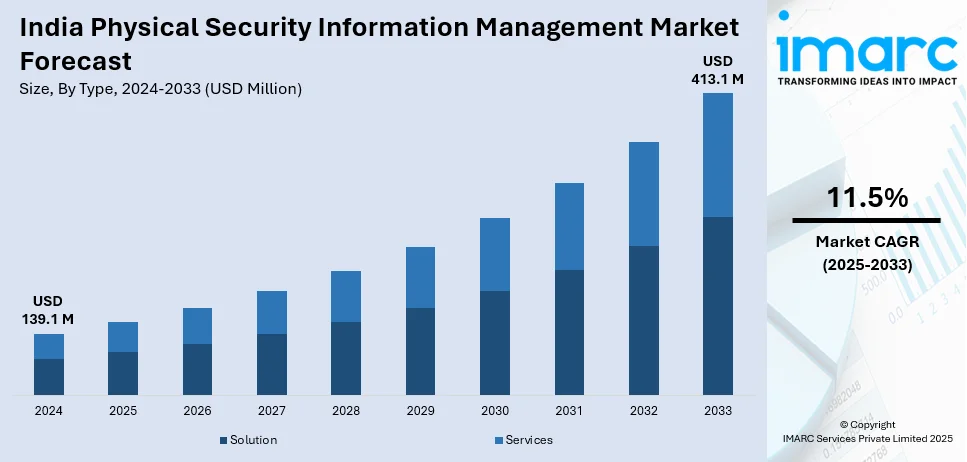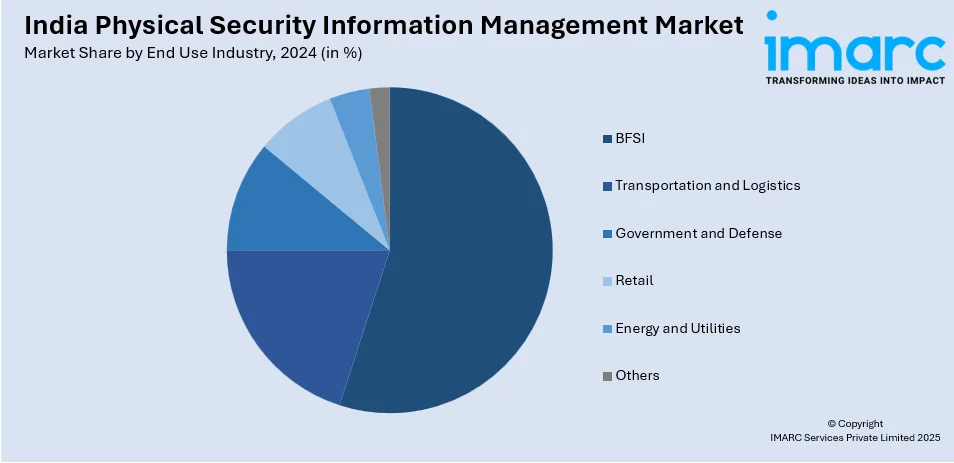
India Physical Security Information Management Market Size, Share, Trends and Forecast by Type, Deployment Mode, End Use Industry, and Region, 2025-2033
India Physical Security Information Management Market Overview:
The India physical security information management market size reached USD 139.1 Million in 2024. Looking forward, IMARC Group expects the market to reach USD 413.1 Million by 2033, exhibiting a growth rate (CAGR) of 11.5% during 2025-2033. The rising security concerns, increased urbanization, government initiatives promoting smart cities and critical infrastructure protection, escalating adoption in commercial sectors, integration of advanced technologies, and regulatory compliance mandates are some of the factors propelling the growth of the market.
|
Report Attribute
|
Key Statistics
|
|---|---|
|
Base Year
|
2024 |
|
Forecast Years
|
2025-2033
|
|
Historical Years
|
2019-2024
|
| Market Size in 2024 | USD 139.1 Million |
| Market Forecast in 2033 | USD 413.1 Million |
| Market Growth Rate 2025-2033 | 11.5% |
India Physical Security Information Management Market Trends:
Strengthening Cybersecurity Leadership
India is advancing its cybersecurity capabilities by investing in specialized training programs to develop a skilled workforce. With cyber threats becoming more sophisticated, a structured approach to cybersecurity education is essential for safeguarding critical infrastructure. This initiative focuses on nurturing experts who can enhance digital security frameworks and address vulnerabilities in real time. As cybersecurity awareness grows, demand for advanced security management solutions is increasing, driving innovation in the physical security information management (PSIM) sector. Strengthened cybersecurity measures are expected to support industries relying on data protection, ensuring resilience against emerging threats. By prioritizing workforce development, India is reinforcing its security infrastructure, making organizations more prepared to handle cyber risks effectively while fostering a stronger digital defense ecosystem. For example, in October 2024, the Indian Computer Emergency Response Team (CERT-In) and the Information Sharing and Analysis Center (ISAC) launched the National Cyber Security Scholar Program (NCSSP) to cultivate cybersecurity experts in India. This initiative aims to enhance the nation's cybersecurity infrastructure by developing a skilled workforce capable of addressing emerging threats. The program's focus on specialized training is expected to bolster the physical security information management (PSIM) market in India, strengthening the country's overall security posture.

To get more information on this market, Request Sample
Strengthening Digital Security
India is reinforcing its cybersecurity infrastructure by prioritizing payment data security and regulatory compliance. Strengthening security frameworks is becoming essential as digital transactions expand, necessitating stricter protocols to prevent cyber threats. Efforts to implement global security standards have led to improved collaboration between financial institutions, regulators, and cybersecurity experts. This shift supports the growing need for advanced security solutions in the Physical Security Information Management (PSIM) market, ensuring robust protection for critical infrastructure. The focus on secure transactions is also driving technological advancements in fraud prevention, real-time monitoring, and data encryption. As businesses and financial institutions adopt these standards, India's cybersecurity landscape is evolving to mitigate risks, enhance trust, and support the expanding digital economy with a resilient security framework. For instance, in April 2024, the PCI Security Standards Council expanded its efforts to strengthen cybersecurity in India and the Middle East. By promoting PCI Security Standards, the initiative enhanced payment data protection and regulatory compliance. This development contributed to India's physical security information management (PSIM) market by advancing secure transactions and fostering stronger collaboration with financial institutions and cybersecurity stakeholders, reinforcing the nation's overall security framework.
India Physical Security Information Management Market Segmentation:
IMARC Group provides an analysis of the key trends in each segment of the market, along with forecasts at the region/country level for 2025-2033. Our report has categorized the market based on Type, Deployment Mode, and End Use Industry.
Type Insights:
- Solution
- Services
The report has provided a detailed breakup and analysis of the market based on the type. This includes solution and services.
Deployment Mode Insights:
- On-premises
- Cloud-based
A detailed breakup and analysis of the market based on the deployment mode have also been provided in the report. This includes on-premises and cloud-based.
End Use Industry Insights:

- BFSI
- Transportation and Logistics
- Government and Defense
- Retail
- Energy and Utilities
- Others
The report has provided a detailed breakup and analysis of the market based on the end use industry. This includes BFSI, transportation and logistics, government and defense, retail, energy and utilities, and others.
Regional Insights:
- North India
- South India
- East India
- West India
The report has also provided a comprehensive analysis of all the major regional markets, which include North India, South India, East India, and West India.
Competitive Landscape:
The market research report has also provided a comprehensive analysis of the competitive landscape. Competitive analysis such as market structure, key player positioning, top winning strategies, competitive dashboard, and company evaluation quadrant has been covered in the report. Also, detailed profiles of all major companies have been provided.
India Physical Security Information Management Market News:
- In January 2025, Keysight Technologies introduced AppFusion, a partner program integrating third-party security and monitoring solutions into its network packet brokers. Collaborations with Forescout, Instrumentix, and Nozomi Networks aim to streamline network and security operations while reducing infrastructure costs. This all-in-one solution allows IT professionals to cut expenses and enhance security monitoring and performance.
- In April 2024, Johnson Controls unveiled security lifecycle management within its OpenBlue services, aiming to enhance building safety and optimize security technology investments. This offering combines the OpenBlue suite with remote support, enabling proactive monitoring and maintenance of security devices.
India Physical Security Information Management Market Report Coverage:
| Report Features | Details |
|---|---|
| Base Year of the Analysis | 2024 |
| Historical Period | 2019-2024 |
| Forecast Period | 2025-2033 |
| Units | Million USD |
| Scope of the Report |
Exploration of Historical Trends and Market Outlook, Industry Catalysts and Challenges, Segment-Wise Historical and Future Market Assessment:
|
| Types Covered | Solution, Services |
| Deployment Modes Covered | On-premises, Cloud-based |
| End Use Industries Covered | BFSI, Transportation and Logistics, Government and Defense, Retail, Energy and Utilities, Others |
| Regions Covered | North India, South India, East India, West India |
| Customization Scope | 10% Free Customization |
| Post-Sale Analyst Support | 10-12 Weeks |
| Delivery Format | PDF and Excel through Email (We can also provide the editable version of the report in PPT/Word format on special request) |
Key Benefits for Stakeholders:
- IMARC’s industry report offers a comprehensive quantitative analysis of various market segments, historical and current market trends, market forecasts, and dynamics of the India physical security information management market from 2019-2033.
- The research report provides the latest information on the market drivers, challenges, and opportunities in the India physical security information management market.
- Porter's five forces analysis assist stakeholders in assessing the impact of new entrants, competitive rivalry, supplier power, buyer power, and the threat of substitution. It helps stakeholders to analyze the level of competition within the India physical security information management industry and its attractiveness.
- Competitive landscape allows stakeholders to understand their competitive environment and provides an insight into the current positions of key players in the market.
Key Questions Answered in This Report
The India physical security information management market was valued at USD 139.1 Million in 2024.
The India physical security information management market is projected to exhibit a CAGR of 11.5% during 2025-2033, reaching a value of USD 413.1 Million by 2033.
The India physical security information management market is driven by rising security concerns, the need for real-time monitoring, and increased focus on integrated security systems. Growing adoption of smart technologies, demand for centralized control, and the push for automation in critical infrastructure are also key contributors to market growth.
Need more help?
- Speak to our experienced analysts for insights on the current market scenarios.
- Include additional segments and countries to customize the report as per your requirement.
- Gain an unparalleled competitive advantage in your domain by understanding how to utilize the report and positively impacting your operations and revenue.
- For further assistance, please connect with our analysts.
 Request Customization
Request Customization
 Speak to an Analyst
Speak to an Analyst
 Request Brochure
Request Brochure
 Inquire Before Buying
Inquire Before Buying




.webp)




.webp)












